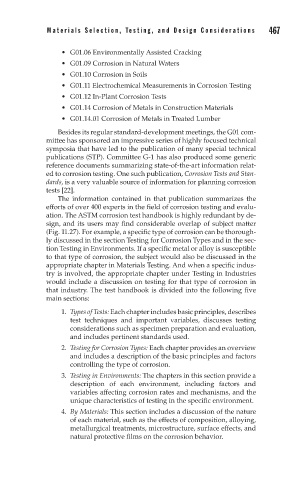Page 500 - Corrosion Engineering Principles and Practice
P. 500
466 C h a p t e r 1 1 M a t e r i a l s S e l e c t i o n , Te s t i n g , a n d D e s i g n C o n s i d e r a t i o n s 467
• G01.06 Environmentally Assisted Cracking
• G01.09 Corrosion in Natural Waters
• G01.10 Corrosion in Soils
• G01.11 Electrochemical Measurements in Corrosion Testing
• G01.12 In-Plant Corrosion Tests
• G01.14 Corrosion of Metals in Construction Materials
• G01.14.01 Corrosion of Metals in Treated Lumber
Besides its regular standard-development meetings, the G01 com-
mittee has sponsored an impressive series of highly focused technical
symposia that have led to the publication of many special technical
publications (STP). Committee G-1 has also produced some generic
reference documents summarizing state-of-the-art information relat-
ed to corrosion testing. One such publication, Corrosion Tests and Stan-
dards, is a very valuable source of information for planning corrosion
tests [22].
The information contained in that publication summarizes the
efforts of over 400 experts in the field of corrosion testing and evalu-
ation. The ASTM corrosion test handbook is highly redundant by de-
sign, and its users may find considerable overlap of subject matter
(Fig. 11.27). For example, a specific type of corrosion can be thorough-
ly discussed in the section Testing for Corrosion Types and in the sec-
tion Testing in Environments. If a specific metal or alloy is susceptible
to that type of corrosion, the subject would also be discussed in the
appropriate chapter in Materials Testing. And when a specific indus-
try is involved, the appropriate chapter under Testing in Industries
would include a discussion on testing for that type of corrosion in
that industry. The test handbook is divided into the following five
main sections:
1. Types of Tests: Each chapter includes basic principles, describes
test techniques and important variables, discusses testing
considerations such as specimen preparation and evaluation,
and includes pertinent standards used.
2. Testing for Corrosion Types: Each chapter provides an overview
and includes a description of the basic principles and factors
controlling the type of corrosion.
3. Testing in Environments: The chapters in this section provide a
description of each environment, including factors and
variables affecting corrosion rates and mechanisms, and the
unique characteristics of testing in the specific environment.
4. By Materials: This section includes a discussion of the nature
of each material, such as the effects of composition, alloying,
metallurgical treatments, microstructure, surface effects, and
natural protective films on the corrosion behavior.

